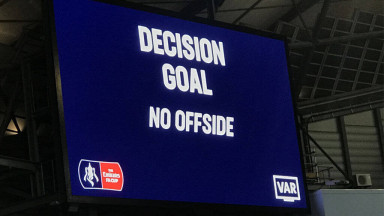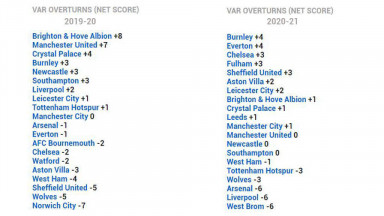VAR: The story so far
Though VAR hasn’t had the most comfortable of starts, the football world is slowly coming to terms with it
By Admin | about 4 years ago
A person looking at VAR on their tablet during a football match
THE KICKOFF
On 16 June 2018 in Kazan, football changed forever.
When France’s Griezmann ran through on goal before being caught by Australia’s Josh Risdon in the penalty box, the referee initially waved play on before he was forced to stop the game and visit the pitch-side monitor. He ended up awarding a penalty for France after the replays showed a foul being committed. This was the first instance of the use of VAR in a major tournament.
""
It’s not possible that, in 2018, everyone in the stadium and their living room knows if a referee has made a big mistake or not, and the only one who doesn’t know is the referee
Russia 2018 ended with France being crowned winners and Mbappe announcing himself as the next in line for the throne. Unlike the Goal-Line Technology, which came out of Brazil 2014 World Cup with unanimous praise, VAR ended up splitting opinions almost down the middle after a month of top-level football.
The president of Fifa, Infantino had said that VAR would help football become “a fairer and more transparent sport”. “It’s not possible that, in 2018, everyone in the stadium and their living room knows if a referee has made a big mistake or not, and the only one who doesn’t know is the referee.” he went on to say.
The group stages of the world cup alone saw 335 incidents checked using VAR. It was noted that the accuracy of match-changing decisions by referees improved from 95% to 99.3%. “We have always said that VAR doesn’t mean perfection – there could still be the wrong interpretation or a mistake – but I think you would agree that 99.3% is very close to perfection,” the Chairman of the FIFA Referees Committee Pierluigi Collina said.
Three years on, after most of the major leagues in Europe having had experienced the technology first hand, VAR is still met with opposition. If a survey by Football Supporters’ Association (an independent organisation representing football fans in England and Wales) is to be believed, more than 44% of the regular match-going fans will turn away from live football because of VAR.
Of the 33,000 people consulted, 94% who watched it on TV said VAR had a negative impact on their viewing experience and both sets of fans agreed that it took away the spontaneous joy of celebrating goals while also took too long to resolve decisions. But how did it get to this point?
VAR IN ENGLAND
It is important to note that while VAR has been far from perfect anywhere in Europe, it has been nothing less than controversial in England. 2019/20 season saw The Premier League introduce VAR and follow its version of the system. This meant, unlike the rest of the leagues, referees having to make calls without looking at the replay on the pitch-side monitor in many cases.
It backfired spectacularly as several incidents, most famously the one where Lo Celso escaped a red card for stamping on Azpilicueta exposed the limitations of the Premier League version. If the referee had gone to the pitchside monitor, Spurs would have got a red card. Also, the global version allowed the linesmen to keep their flags down until the attacking phase was completed but the premier league version instructed them to raise their flags for all offside situations. This added to the confusion of the viewers and players alike as evidenced by Jonjo Shelvey’s goal against Sheffield United when the defenders and Dean Henderson stood frozen as Newcastle scored.
Picture Courtesy of : Rlwjones
A VAR decision during an FA Cup match at the Etihad Stadium, Manchester
End-of-season statistics for the league showed that a total of 67 goals were disallowed. Liverpool and Bournemouth both had the maximum number of goals disallowed with 6 each and Man United, Southampton, and Newcastle had no goals disallowed.
According to ESPN, there were a total of 109 overturns with 27 of them leading to goals and 56 of them leading to disallowed goals. Below shows the net score of VAR overturns for the whole season.
Coming into the 2020/2021 season, FIFA took over the global VAR project which meant the Premier League had no choice but to follow the same rules as everyone else. Even though the marginal offside calls remained as anxiety-inducing as ever, the pitchside monitors started being used more frequently and handball situations inside the penalty box were better dealt with, which wasn’t the case the previous season.
This time, the league saw a total of 123 overturns, out of which 34 ended up leading to goals and 42 leading to disallowed goals. The below image shows the net score of VAR overturns for each team.
Despite all this, the last two seasons have seen almost every matchweek marred by a contentious handball decision or a borderline offside call. The post-match discussions have revolved around the decisions rather than the actual game. Managers and players alike have complained live on television that VAR is ruining football. It has taken over the narrative around especially the big games. Officials are under more scrutiny than ever after getting decisions wrong, as fans can point to the fact that they got a match-changing wrong despite the technology.
Picture Courtesy of : ESPN
VAR net overturns for the season 2019-20 and 2020-21
BUNDESLIGA
Unlike in England, Germany is one country where there has been much better work done in implementing VAR. That is not to say there is no opposition, as a lot of season ticket holders still prefer the traditional way.
VAR was first introduced in the German league in 2017 and it’s since evolved into a more acceptable and balanced system. The use of the pitchside monitor is efficient enough to not take too long and unlike in 2017, the screens in the stadiums display the relevant information to the fans.
SERIE A
VAR was first introduced in Serie A in 2017 and the main thing the fans found frustrating about it was how long it took to arrive at a decision. But by the 2019/20 season, it took less time for officials to arrive at a decision and VAR only intervened if the referee missed something that was deemed significant enough.
The wide consensus seems to be that the technology can be useful if used properly, which is why the Italian FA decided to open the world’s first VAR training centre to make sure the officials are well-versed in the use of the technology.
LA LIGA
Like in England and Italy, VAR failed to get going immediately when introduced. Fans and players were equally concerned about how it interfered with the flow of the game. But by the second season (2019-20) it became markedly better, with VAR brought in only following a “clear and obvious” error by the referee.
LIGUE 1
VAR has had a tougher time in Ligue 1 than most leagues in Europe but the French football fans seem to be coming round to the fact that it won’t be going anywhere anytime soon. Le Parisien reports that, as of September, 90% of people interviewed responded positively to VAR. The future for VAR looked bleak following a significant error in the most high profile French game when Marseille’s equaliser was chalked off for an alleged Kevin Strootman foul on Marquinhos. The replays showed the referee should’ve played on.
EURO 2020
Ever since VAR’s introduction in the world cup 2018, it was intriguing to see how it performed in an international tournament after the technology has been around for a couple of years. So, when Euro 2020 came round in 2021, optimism wasn’t high and there was pressure on the officials and UEFA to deliver.
""
We need to find the correct balance in relation to VAR intervention because our target is to keep football like it is
But, much to everybody’s surprise, Roberto Rosetti and his team of officials delivered. According to UEFA, the time taken for VAR to make a decision was the lowest seen in one of their competitions, at about 100 seconds per intervention after 36 matches.
“The objective is to intervene for clear and obvious mistakes – minimum interference for maximum benefit,” Roberto Rosetti said. “We need to find the correct balance in relation to VAR intervention because our target is to keep football like it is.”
The magnitude of change VAR has forced on any football fan in the way they experience football is too much to get used to in just two years. As the FSA survey proves, it shouldn’t be a surprise that football fans, whether they’re season ticket holders or overseas fans who watch the game on TV, don’t enjoy having to wait a good few seconds before celebrating a goal. Waiting to celebrate your team scoring a goal isn’t “another layer of adrenaline” as the president of FIFA, Infantino, seems to think. It is worth arguing that people go to the game to have a good time and fans can have a good time despite their team losing, but taking the whole genuineness away from the experience can mean they stop having a good time despite winning.
That said, Euro 2020 might just have saved VAR in the short term. During a difficult time, the competition ended up being a lifeline for the technology. FIFA and FAs would do well to study what went right and replicate it in the domestic club competitions. UEFA had the pick of the elite from every continent, which is no doubt a luxury but it points to the fact that VAR depends largely on the individuals using it.
Authorities will have to work on providing better training to officials to make sure the game remains as flawless as possible and the spectacle isn’t ruined because of human error, because make no mistake, the jury is still out.












